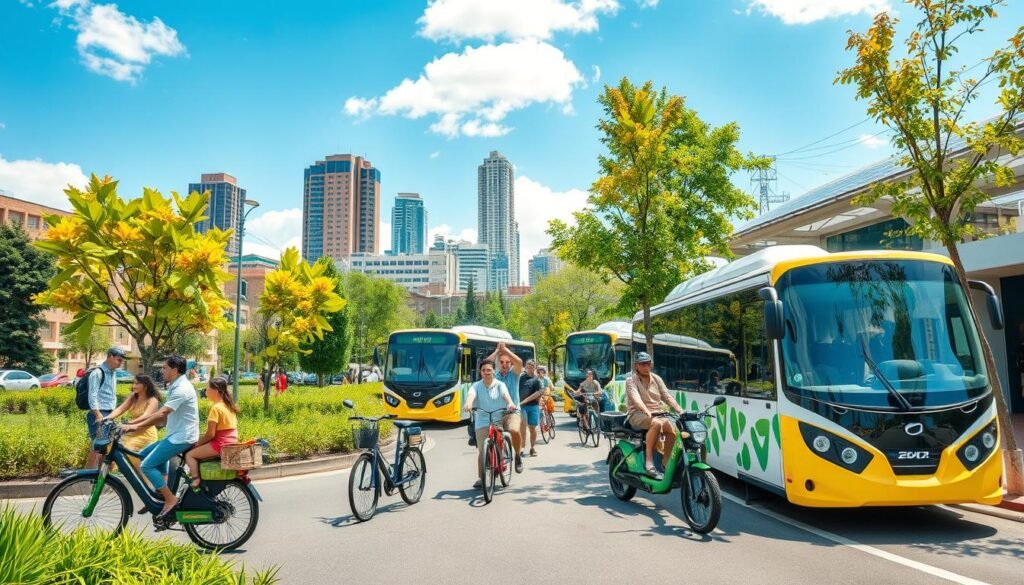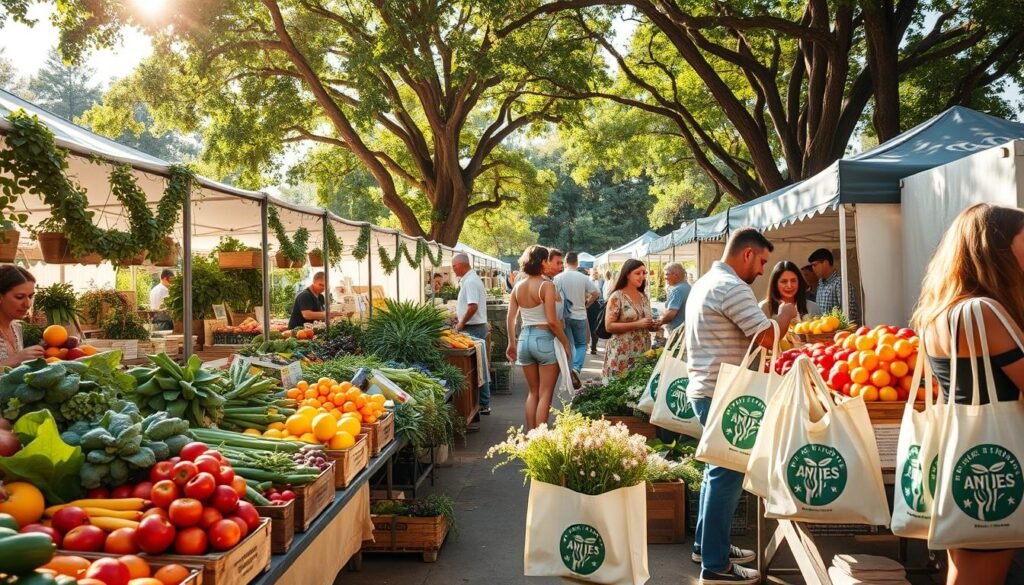In today’s fast world, caring for the environment is more important than ever. Living sustainably is good for our planet and for us. Simple green living tips can help us live healthier and save money.
This article will show you how to live more sustainably. You’ll learn about making eco-friendly choices and using energy-saving home solutions. By understanding sustainability, you can make choices that help our planet.
Key Takeaways
- Adopting an eco-friendly lifestyle has numerous benefits for the environment, personal well-being, and financial savings.
- Understanding the pillars of sustainability, environmental impact, and developing a green mindset are crucial first steps.
- Implementing green living practices in daily routines, home energy solutions, and transportation choices can significantly reduce your environmental impact.
- Embracing sustainable shopping habits, natural cleaning methods, water conservation, and organic gardening further contribute to a greener lifestyle.
- Making small, incremental changes can lead to a more sustainable, eco-conscious way of living that benefits both you and the planet.

Understanding the Fundamentals of Sustainable Living
Sustainable living is crucial for a greener future. It’s based on three main pillars: environmental, social, and economic. Understanding these pillars is key to living sustainably.
The Three Pillars of Sustainability
The environmental pillar is about cutting our carbon footprint and saving resources. The social pillar is about fairness and community well-being. The economic pillar makes sure sustainable living is affordable and beneficial for the future.
Environmental Impact Assessment Basics
First, we need to assess our environmental impact. This means looking at our daily habits and waste. By doing this, we can find ways to reduce our environmental conservation and live more sustainably.
Building a Green Mindset
Having a green mindset is vital for sustainable living. It means changing our priorities and adopting eco-friendly habits. By doing this, we can make a big difference and inspire others to join us.
“The greatest threat to our planet is the belief that someone else will save it.”
– Robert Swan
Green Living Tips for Daily Home Routines
Living eco-friendly at home can greatly help the environment. Simple steps like saving energy, conserving water, and reducing waste can make a big difference. Here are some easy green living tips for your daily life.
Optimize Energy Efficiency
Reducing energy use is key. Turn off lights and gadgets when not needed. Use natural light instead. Also, switch to energy-efficient LED bulbs to save money and the planet.
Embrace Water Conservation
- Shorten your showers and use low-flow showerheads to save water.
- Fix leaks fast to avoid wasting water.
- Think about using greywater systems for irrigation or flushing toilets.
Reduce Household Waste
- Follow the 3Rs: Reduce, Reuse, and Recycle to cut down on waste.
- Use reusable bags, bottles, and containers to avoid single-use plastics.
- Compost food and yard waste to keep it out of landfills.
By following these green living tips, we can help the planet. Remember, every small action counts when done regularly.
| Tip | Benefit |
|---|---|
| Turn off lights and electronics when not in use | Reduces energy consumption and lowers utility bills |
| Install low-flow showerheads | Conserves water and reduces energy needed for water heating |
| Compost food scraps | Diverts waste from landfills and creates nutrient-rich soil for plants |

“Small changes, when practiced consistently, can lead to a more sustainable future.” – Environmental Advocate
Energy-Efficient Home Solutions and Practices
Choosing energy-efficient home solutions is key to cutting down your carbon footprint. Smart thermostats, LED lights, and using natural light are great ways to start. These steps not only save you money but also help the planet.
Smart Thermostat Implementation
Getting a smart thermostat is an easy way to save energy. These devices learn your temperature preferences and adjust automatically. They help you save on bills and reduce your carbon footprint.
LED Lighting Benefits
Switching to LED bulbs is a smart move. They use 75% less energy than old bulbs and last much longer. Making this change can greatly reduce your energy use and carbon footprint.
Natural Light Optimization
| Benefit | Description |
|---|---|
| Energy Savings | Using natural light cuts down on the need for artificial light, saving energy and money. |
| Health and Wellness | Natural light boosts mood, productivity, and helps with body rhythms. |
| Sustainability | Solar power is a green way to light your home. |
By smartly placing windows and using reflective surfaces, you can let in more natural light. This simple step can make a big difference in your energy use and sustainability efforts.

Zero-Waste Kitchen Strategies
Starting a sustainable lifestyle begins in the kitchen. By using zero-waste kitchen strategies, you can cut down on landfill waste. Let’s look at some easy tips to make your kitchen a place of waste reduction and recycling practices.
One key way to cut down on waste is through careful meal planning. Before you shop, check what you already have at home. This helps you avoid buying too much and reduces food waste. Also, use reusable containers and sustainable storage solutions to keep food fresh longer.
- Start a composting system to turn food scraps into soil for your garden or plants.
- Replace single-use plastics like bags and wrap with eco-friendly alternatives like reusable silicone bags or beeswax wrap.
- Buy refillable containers for items like flour, sugar, and spices to cut down on packaging waste.
By adopting these zero-waste kitchen strategies, you’ll lessen your environmental footprint. You’ll also live a more eco-friendly lifestyle that’s good for your home and the planet.
| Conventional Kitchen Practices | Zero-Waste Kitchen Alternatives |
|---|---|
| Single-use plastic bags and wrap | Reusable silicone bags, beeswax wrap |
| Disposable food storage containers | Glass or stainless steel containers |
| Plastic-wrapped produce | Mesh bags, reusable produce bags |
| Individually packaged snacks | Bulk bin purchases, homemade alternatives |
Remember, small changes in the kitchen can make a big difference. They help reduce your household’s waste and support a greener lifestyle. Start using these zero-waste strategies and join the journey towards a sustainable future.
Sustainable Transportation Choices
Living an eco-friendly lifestyle means reducing our carbon footprint. Making sustainable transportation choices is a key part of this. Options like electric vehicles, bike-friendly commuting, and public transit can help. These choices minimize our environmental impact while we’re on the move.
Electric Vehicle Benefits
Electric vehicles (EVs) are changing the game in sustainable transport. They cut down on direct emissions, making our environment cleaner. Plus, they’re getting cheaper and their batteries are getting better, making them a smart choice for those who care about the planet.
Bike-Friendly Lifestyle Tips
- Try to cycle for your daily commute or for running errands.
- Get a good bike and safety gear to enjoy the ride.
- Look for bike-friendly paths and areas in your area for a safe ride.
Public Transit Advantages
Using public transport like buses, trains, or subways is another great way to cut down on emissions. It lets you share rides, which reduces your carbon footprint. Cities are also working to make public transit better, making it easier to live green.
| Transportation Mode | Carbon Footprint Reduction | Eco-Friendly Benefits |
|---|---|---|
| Electric Vehicles | High | Eliminate direct emissions, increased affordability |
| Bicycling | Moderate | Zero emissions, improved physical fitness |
| Public Transit | Moderate | Shared rides, efficient transportation networks |
Choosing sustainable transport options can greatly reduce your carbon footprint. Every small step towards a greener lifestyle helps protect our planet for the future. So, let’s make a difference together.

Eco-Friendly Shopping and Consumer Habits
In our quest for a more sustainable living, conscious shopping choices play a crucial role. By adopting eco-friendly consumer habits, we can significantly reduce our environmental impact and support a greener future.
One key aspect of sustainable shopping is prioritizing products made from natural and renewable materials. Look for items labeled with eco-friendly certifications, such as organic, recycled, or biodegradable. These designations ensure your purchases align with your sustainable living goals.
Another important consideration is supporting local and ethical businesses. Patronizing small, community-based shops and artisans not only reduces your carbon footprint but also helps foster a vibrant eco-friendly lifestyle in your area.
Mindful consumption is also crucial. Before making a purchase, ask yourself if the item is truly necessary or if it aligns with your long-term needs. Embracing a minimalist approach and opting for quality over quantity can have a profound impact on reducing waste and promoting sustainable living.
| Eco-Friendly Shopping Tips | Benefits |
|---|---|
| Choose products with eco-friendly certifications | Supports sustainable and ethical manufacturing practices |
| Prioritize local and small businesses | Reduces carbon footprint and supports the community |
| Practice mindful consumption | Minimizes waste and promotes a more eco-friendly lifestyle |
By making informed and intentional shopping choices, we can collectively contribute to a healthier planet and a more sustainable living future.
“The only way forward, if we are going to improve the quality of the environment, is to get everybody involved.” – Richard Rogers

Natural Home Cleaning Solutions
We’re all getting more aware of how our cleaning products affect the planet. Luckily, there are many green living tips for a clean, eco-friendly lifestyle. We’ll look at DIY cleaning recipes, safe alternatives, and green cleaning tools to change your cleaning habits.
DIY Cleaning Product Recipes
Making your own natural products at home is a great way to avoid harsh chemicals. You can make everything from all-purpose cleaners to gentle tile scrubs. Here are a few easy, effective DIY recipes to try:
- All-Purpose Cleaner: Mix one part white vinegar and one part water in a spray bottle. Add a few drops of lemon or essential oil for a refreshing scent.
- Tile and Grout Scrub: Combine baking soda, hydrogen peroxide, and a few drops of dish soap to create a paste. Scrub onto tiles and let sit before rinsing.
- Glass Cleaner: Mix equal parts white vinegar and water in a spray bottle. Wipe clean with a microfiber cloth for streak-free windows and mirrors.
Non-Toxic Alternatives
If DIY isn’t your thing, there are many eco-friendly lifestyle brands with safe cleaning products. Look for products without harsh chemicals, fragrances, and harmful ingredients. Castile soap, plant-based surfactants, and essential oil-based cleaners are good alternatives.
Sustainable Cleaning Tools
For more green living tips, consider using reusable, sustainable cleaning tools. Microfiber cloths, brushes, and refillable spray bottles are great for reducing waste. Making small changes can make a big difference in your cleaning routine.

Choosing natural home cleaning solutions is a simple way to live more sustainably. With a bit of creativity and the right tools, you can keep your home clean and reduce your environmental impact. Start using these green living tips today for a cleaner, healthier home.
Water Conservation Methods for Home and Garden
Water conservation is key to living sustainably. We can use several methods at home and in our gardens to save water. These actions help reduce our water use, save money, and protect our natural resources.
Efficient Irrigation Systems
Using efficient irrigation systems is a big step in saving garden water. Look into drip irrigation or soaker hoses. They deliver water right to the roots, cutting down on evaporation and saving water.
Rainwater Harvesting
Collecting and using rainwater is a smart move. Set up rain barrels or cisterns to catch rain. Then, use this water for plants, washing cars, or even flushing toilets. It lessens the need for city water.
Water-Saving Appliances
Upgrade to high-efficiency appliances at home. Choose Energy Star-rated washing machines, dishwashers, and faucets. They use less water and save energy.
Water-Conscious Habits
Small daily changes can help a lot. Turn off the tap while brushing teeth, take shorter showers, and avoid letting water run. Also, use a broom to clean outside instead of a hose. Water your garden when it’s coolest to cut down on evaporation.
By following these green living tips, you help save our water resources. You also contribute to a more sustainable world.
| Water Conservation Method | Benefits |
|---|---|
| Efficient Irrigation Systems | Reduced water usage, minimized evaporation |
| Rainwater Harvesting | Decreased demand on municipal water, cost savings |
| Water-Saving Appliances | Lower water consumption, energy efficiency |
| Water-Conscious Habits | Immediate water savings, environmental impact reduction |
“Saving water is not just a personal responsibility, but a collective duty that we all share to protect our planet’s finite resources.”
Creating an Organic Home Garden
Starting an organic garden is a big step towards living more sustainably. It lets you enjoy fresh, homegrown food and helps the environment. Let’s look at what you need to create a green space in your backyard.
Composting Basics
Composting is key to a good organic garden. It turns waste into soil that feeds your plants. Learning to compost helps reduce waste and makes your garden grow strong.
Find out how to mix green and brown materials right. This will make your compost pile a treasure for gardeners.
Seasonal Planting Guide
Organic gardening works best when you plant with the seasons. A seasonal guide will show you when to plant and harvest. This way, you’ll grow everything from leafy greens to herbs well.
Natural Pest Control
Organic gardens need natural ways to fight pests. Learn about natural repellents, planting friends, and beneficial bugs. These methods keep your garden safe without harming it.

Hello, I’m Jane, founder of Home Vibe Ideas. I’m here to inspire stylish Home Design, modern Smart Living, beautiful Outdoor Spaces, and creative DIY Projects to help you create a home that’s uniquely yours.
Disclosure: This post contains affiliate links. If you click on a link and make a purchase, we may earn a small commission at no additional cost to you. The content on this site was created with the help of AI technology.


